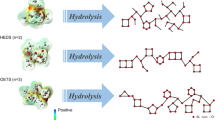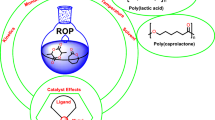Abstract
Four titanium(IV) alkoxides, namely: Ti(IV) n-propoxide (1), Ti(IV) n-butoxide (2), Ti(IV) tert-butoxide (3), and Ti(IV) 2-ethylhexoxide (4), have been used as initiators in the bulk ring-opening polymerization (ROP) of ε-caprolactone (ε-CL). The influence of the alkoxide group on the course of the ROP of ε-CL was investigated by means of 1H-NMR and differential scanning calorimetry (DSC). The 1H-NMR spectra confirmed that the ROP reaction of ε-CL proceeded via the widely accepted coordination-insertion mechanism for each of the four initiators. Isoconversional methods have been used to evaluate non-isothermal DSC data via the equations of Friedman, Kissinger-Akahira-Sunose (KAS) and Ozawa-Flynn-Wall (OFW). The kinetic studies showed that the polymerization rate for the four initiators (1-4) was in the order of 1 > 2 ≈ 4 > 3. The lowest activation energies (40–47, 42–44, and 49–52 kJ/mol for the Friedman, KAS and OFW methods respectively) were found in the polymerizations using Ti(IV) n-propoxide (1), while the highest activation energies (84–107, 77–87, and 80–91 kJ/mol for the Friedman, KAS and OFW methods respectively) were obtained using Ti(IV) tert-butoxide (3). Differences in the rates of polymerization and the activation energies amongst the four initiators appeared to be governed mainly by the different degrees of steric hindrance in the initiator structure. These results represent important findings regarding the steric influence of the alkoxide groups on the kinetics of the ROP of ε-CL initiated by titanium(IV) alkoxides.











Similar content being viewed by others
References
Seyednejad H, Ghassemi AH, van Nostrum CF, Vermonden T, Hennink WE (2011) J Controlled Release 152:168–176
Khan JH, Schue F, George GA (2009) Polym Int 58:296–301
Albertsson AC, Varma IK (2003) Biomacromolecules 4:1466–1486
Kricheldorf HR, Berl M, Scharnagl N (1988) Macromolecules 21:286–293
Dubois P, Barakat I, Jerome R, Teyssie P (1993) Macromolecules 26:4407–4412
Kricheldorf HR (2001) Chemosphere 43:49–54
Delcroix D, Couffin A, Susperregui N, Navarro C, Maron L, Martin-Vaca B, Bourissou D (2011) Polym Chem 2:2249–2256
Cheng G, Fan X, Pan W, Liu Y (2010) J Polym Res 17:847–851
Wu J, Yu T-L, Chen C-T, Lin C-C (2006) Coord Chem Rev 250:602–626
Gao A, Mu Y, Zhang J, Yao W (2009) Eur J Inorg Chem 2009:3613–3621
Kleawkla A, Molloy R, Naksata W, Punyodom W (2008) Adv Mat Res 55–57:757–760
Huang B-H, Lin C-N, Hsueh M-L, Athar T, Lin C-C (2006) Polymer 47:6622–6629
Sheng H, Li J, Yao YZY, Shen Q (2009) J Appl Polym Sci 112:454–460
Li P, Zerroukhi A, Chen J, Chalamet Y, Jeanmaire T, Xia Z (2008) J Appl Polym Sci 110:3990–3998
Cayuela J, Bounor-Legare V, Cassagnau P, Michel A (2006) Macromolecules 39:1338–1346
Xia Z, Zerroukhi A, Chalamet Y, Chen J (2008) J Appl Polym Sci 109:1772–1780
Li P, Zerroukhi A, Chen J, Chalamet Y, Jeanmaire T, Xia Z (2008) J Polym Sci Part A: Polym Chem 46:7773–7784
Asandei AD, Chen Y, Adebolu OI, Simpson CP (2008) J Polym Sci Part A: Polym Chem 46:2869–2877
Parssinen A, Kohlmayr M, Leskela M, Lahcini M, Repo T (2010) Polym Chem 1:834–836
Takeuchi D, Nakamura T, Aida T (2000) Macromolecules 33:725–729
Chen C-T, Huang C-A, Huang B-H (2004) Macromolecules 37:7968–7973
Dumklang M, Pattawong N, Punyodom W, Meepowpan P, Molloy R, Hoffman M (2009) Chiang Mai J Sci 36(2):136–148
Ramírez-Hernández A, Martínez-Richa A (2010) J Appl Polym Sci 115:2288–2295
Vyazovkin S (1997) J Therm Anal 49:1493–1499
Vyazovkin S (1996) Int J Chem Kinet 28:95–101
Vyazovkin S, Sbirrazzuoli N (1996) Macromolecules 29:1867–1873
Fernandez d’Arlas B, Rueda L, Stefani PM, de la Caba K, Mondragon I, Eceiza A (2007) Thermochim Acta 459:94–103
Papadimitriou SA, Papageorgiou GZ, Bikiaris DN (2008) Eur Polym J 44:2356–2366
Laidler KJ (1984) J Chem Educ 61:494
Flynn JH (1997) Thermochim Acta 300:83–92
Friedman HL (1964) J PolymSci Part C: Polym Sym 6:183–195
Akahira T, Sunose T, Report R (1971) CHIBA Inst Technol 16:22
Ozawa T (1965) Bull Chem Soc Jpn 38:1881
Flynn JH, Wall LA (1966) Polym Lett 4:191
Doyle CD (1962) J Appl Polym Sci 6:639–642
Flynn JH (1983) J Therm Anal 27:95
Acknowledgements
This work was supported by the Center of Excellence for Innovation in Chemistry, Commission on Higher Education, Ministry of Education, and the National Research University Project under Thailand’s Office of the Higher Education Commission, and the Graduate School of Chiang Mai University.
Author information
Authors and Affiliations
Corresponding author
Rights and permissions
About this article
Cite this article
Meelua, W., Molloy, R., Meepowpan, P. et al. Isoconversional kinetic analysis of ring-opening polymerization of ε-caprolactone: Steric influence of titanium(IV) alkoxides as initiators. J Polym Res 19, 9799 (2012). https://doi.org/10.1007/s10965-011-9799-8
Received:
Accepted:
Published:
DOI: https://doi.org/10.1007/s10965-011-9799-8




